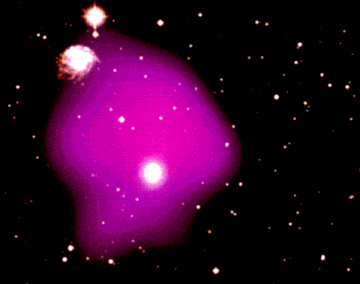 Cosmologists theorized the need for dark matter to account for hidden mass in our universe. Yet, as the name implies, it is proving rather hard to find. Now astronomers believe they see hints of it in ancient galactic collisions.
Cosmologists theorized the need for dark matter to account for hidden mass in our universe. Yet, as the name implies, it is proving rather hard to find. Now astronomers believe they see hints of it in ancient galactic collisions.
[div class=attrib]From New Scientist:[end-div]
Colliding clusters of galaxies may hold clues to a mysterious dark force at work in the universe. This force would act only on invisible dark matter, the enigmatic stuff that makes up 86 per cent of the mass in the universe.
Dark matter famously refuses to interact with ordinary matter except via gravity, so theorists had assumed that its particles would be just as aloof with each other. But new observations suggest that dark matter interacts significantly with itself, while leaving regular matter out of the conversation.
“There could be a whole class of dark particles that don’t interact with normal matter but do interact with themselves,” says James Bullock of the University of California, Irvine. “Dark matter could be doing all sorts of interesting things, and we’d never know.”
Some of the best evidence for dark matter’s existence came from the Bullet cluster![]() , a smash-up in which a small galaxy cluster plunged through a larger one about 100 million years ago. Separated by hundreds of light years, the individual galaxies sailed right past each other, and the two clusters parted ways. But intergalactic gas collided and pooled on the trailing ends of each cluster.
, a smash-up in which a small galaxy cluster plunged through a larger one about 100 million years ago. Separated by hundreds of light years, the individual galaxies sailed right past each other, and the two clusters parted ways. But intergalactic gas collided and pooled on the trailing ends of each cluster.
Mass maps of the Bullet cluster showed that dark matter stayed in line with the galaxies instead of pooling with the gas, proving that it can separate from ordinary matter. This also hinted that dark matter wasn’t interacting with itself, and was affected by gravity alone.
Musket shot
Last year William Dawson of the University of California, Davis, and colleagues found an older set of clusters seen about 700 million years after their collision. Nicknamed the Musket Ball cluster, this smash-up told a different tale. When Dawson’s team analysed the concentration of matter in the Musket Ball, they found that galaxies are separated from dark matter by about 19,000 light years.
“The galaxies outrun the dark matter. That’s what creates the offset,” Dawson said. “This is fitting that picture of self-interacting dark matter.” If dark matter particles do interact, perhaps via a dark force, they would slow down like the gas.
This new picture could solve some outstanding mysteries in cosmology, Dawson said this week during a meeting of the American Astronomical Society in Long Beach, California. Non-interacting dark matter should sink to the cores of star clusters and dwarf galaxies, but observations show that it is more evenly distributed. If it interacts with itself, it could puff up and spread outward like a gas.
So why doesn’t the Bullet cluster show the same separation between dark matter and galaxies? Dawson thinks it’s a question of age – dark matter in the younger Bullet simply hasn’t had time to separate.
[div class=attrib]Read the entire article after the jump.[end-div]
[div class=attrib]Image: An overlay of an optical image of a cluster of galaxies with an x-ray image of hot gas lying within the cluster. Courtesy of NASA.[end-div]
